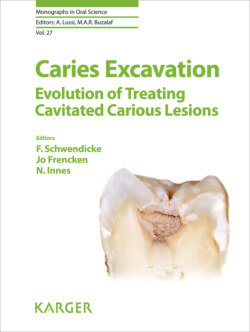Читать книгу Caries Excavation: Evolution of Treating Cavitated Carious Lesions - Группа авторов - Страница 39
Caries Detection Methods Visual-Tactile Inspection
ОглавлениеThe first and most important method to detect and to diagnose caries is visual-tactile inspection [8]. The eyes are able to discriminate by colour matching all clinically relevant caries stages from sound tooth surfaces to dental restorations. The eyes are also capable of seeing surface discontinuities, ranging from microcavities to large cavities. Further advantages include clinical visual inspection being fast, inexpensive, radiation-free, and helping to establish doctor-patient contact. As a prerequisite, the eyes should be functioning perfectly [9]. It is known that after the age of about 40 years the eyes have lower accommodation capabilities, the reflection glare increases, and the visual acuity decreases [10, 11]. Therefore, the use of moderately high magnification loupes (about ×2.5) [12] is recommended to compensate for reduced vision at increased age [13]. It has been shown that magnification greater than ×2.5 significantly decreased specificity, irrespective of the duration of clinical experience [13]. Additional illumination is helpful, but if too intense (>20,000 lx) it might actually reduce the accuracy of caries detection [14]. Lastly, a visual caries detection system should be used that takes into account the different stages of carious lesion development, and not only those that have reached a stage of cavitation. Several main caries detection and notation systems are available (Nyvad system [6], The International Caries Detection and Assessment System (ICDAS) [15], and the Caries Assessment Spectrum and Treatment (CAST) [16]). CAST covers the total spectrum of dental caries and has been designed for epidemiological purposes, whereas ICDAS and the so-called Nyvad criteria can be used also in the private office. For epidemiological data acquisition, ICDAS and Nyvad criteria have their limitations [see the chapter by Frencken; this vol., pp. 11–23]. It has been shown that proper training is needed to use either system to increase reliability, validity, and accuracy. The outcome of visual caries detection trials is dependent on the circumstances under which clinical visual inspection takes place, on the caries prevalence of the respective patients/subjects or, in laboratory experiments, on caries levels [17], and caries detection thresholds [18, 19]. Thus, in a recent review, a moderate to high degree of heterogeneity was found in visual caries detection studies [20]. In visual caries detection studies assessing initial and more advanced caries lesions, pooled sensitivities and specificities were reported to be 0.27–0.81 and 0.73–0.99, respectively, with a tendency towards lower sensitivity and higher specificity in clinical settings [20].
Visual-tactile inspection works well on visible surfaces, but the detection of carious lesions in the approximal surface is more difficult, and therefore more biased [20]. Furthermore, dentine carious lesions in occlusal surfaces with seemingly intact fissures (so-called “hidden caries”) is usually detected at a relatively late stage when discolouration of dentine shines through the enamel [21]. Approximal surfaces and occlusal grooves and fissures are the sites where most carious lesions are found. On approximal surfaces, a small hook-like probe might add information on a present cavitation, but this test is reliable only when the cavitation itself or the area beneath the contact zone of two adjacent teeth are large enough for the probe to enter. A sharp-ended probe should only be used to gently touch the surface of the tooth to assess lesion roughness, but this test seems to be not reliable [22]. Firm pressing of a sharp probe in order to test the “stickiness” of a fissure should be refrained from because irreversible damage occurs that results in more invasive treatment [23]. The use of a periodontal probe is recommended to scan the surface for irregularities, such as microcavities [24].
Theoretically, visual inspection can be performed on approximal surfaces when the patient receives orthodontic separating rubber bands for 2 to 3 days to create space between the teeth [examples of this are shown in Fig. 3 in Schwendicke, Lamont and Innes, this vol., p. 36 and Fig. 3 in Fontana and Innes, this vol., p. 107]. This method works well for single approximal spaces and has been used as a gold standard in several clinical trials [25, 26]. For multiple approximal spaces, however, the effect would be less pronounced. This method also has the disadvantages of discomfort for the patient and requiring several appointments. Whilst in other medical disciplines several appointments for several tests to derive a complex diagnosis are usually accepted by patients, in dentistry there seems to be a need for immediate findings and treatment decisions [2].
Cleaning of teeth is necessary to inspect the tooth surfaces [27, 28]. Having defined approximal surfaces and occlusal fissures and grooves as high-risk caries sites, these sites are often covered by plaque or even food remnants that render a meticulous visual inspection impossible without prior cleaning. It is essential that plaque present be identified by means of a probe, because the position of the plaque may be an indicator for the presence of “active” enamel carious lesion(s) [6]. Clinically, the patient can be asked to brush the teeth in the usual way before inspection. This facilitates the identification of chronically neglected sites easier. Depending on the cleaning habits of the patients, chronically swollen and bleeding papillae hamper visual inspection of the interdental areas, and an initial periodontal therapy might be necessary before assessing the surface for the presence of a carious lesion.
Regarding occlusal caries diagnostics, some authors recommend the use of air abrasion because the small particles are able to clean the fissures better than pumice and brush or rubber cup [29]. Dental practitioners should be aware of the powder they use, because alumina air abrasion changes the surface morphology, especially of brittle enamel in carious fissures [30]. Sodium bicarbonate powder will cause bleeding when targeting the gums [31], so for cleaning prior to visual inspection air-abrasion with atraumatic glycine or erythritol powders should always be used [32].
